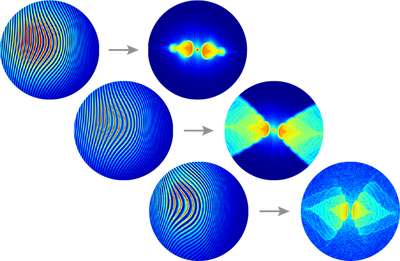Frequency-domain metrology

To measure the deflection of the ferrofluid deformable mirror, I built a custom Fizeau interferometer. In conjunction, I developed software tools to retrieve the mirror topography from each fringe pattern. The technique I implemented is called Fourier fringe analysis (FFA).
FFA requires only one image frame, so it’s simpler in hardware than phase-shifting interferometry. The theory is elegant but it can be difficult to implement.
Conventional FFA is based on a two-beam interference model and its success hinges on the frequency-domain filtering. I observed detrimental fringe “print-through” in the final measurement of the deformed mirror with the custom Fizeau. I showed in simulation that in a high-finesse cavity with a deformable mirror, multiple-beam interference and beam walk-off may introduce harmonics in the frequency domain that limit frequency-domain filter effectiveness.

Each pair of images here shows a set of interference fringes and its Fourier transform. The top pair simulates two-beam interference, the middle pair simulates multiple-beam interference (notice the narrower fringes) and exhibits the harmonics in the frequency domain, and the bottom pair shows real data.